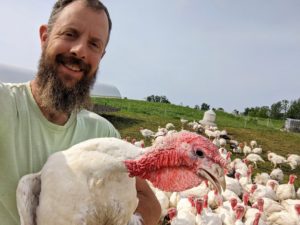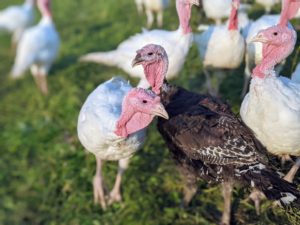Getting Started with Pasture Raised Turkeys
This is the first in a series of articles on how farmers can include pasture raised turkeys in their operation.
On our farm, Wrong Direction Farm, we raise hundreds of turkeys each year, along with several thousand pasture raised chickens. Please don’t tell the birds that I have favorites, but I enjoy raising turkeys more than chickens. They are better grazers than chickens and they don’t suffer from some of the mobility problems that plague fast growing chicken breeds. Also, turkeys are just more interesting to watch.

Wrong Direction Farm pasture raises both chickens and turkeys, but the farmer shared that he does play favorites and has found turkeys to be better grazers, among other benefits.
Dave Perozzi / Wrong Direction Farm
While there exists a relatively good amount of information about raising chickens on pasture, the resources are a bit sparser for turkeys. Anyone with chicken experience will be well served by this background, but there are important aspects where we find a divergence between turkey and chicken habits and needs.
Note that most of what I write applies primarily to turkeys of the broad breasted varieties (white, bronze, or black). Our farm does not raise heritage turkey breeds. Heritage turkey breeds can be a great farm enterprise as well, but with their slower growth and their propensity to fly away at inconvenient times, we decided to stick with the standard heavier crossbreeds. For certain markets, the premium prices for heritage turkeys can provide a great incentive for farmers to make the management changes necessary to raise these older breeds. I am not suggesting that anyone dismiss heritage turkeys, but only to be aware that there are some additional complexities involved with raising them.
Turkeys on Pasture
Compared to the other domesticated birds raised for meat, there is no bird quite so well-suited to pasture as the turkey. Turkeys are an American bird, so they are at home in our climate and environment. Tasting a pasture raised turkey, one that has had daily access to fresh grass, you’ll know the difference immediately. The dark meat is richer, and the white meat is more forgiving, so it doesn’t dry out as quickly.
Coming from a pasture raised chicken background, I was interested to note the advantages of pasture raised turkeys over chickens. Turkeys graze more persistently, and with their greater size they can eat larger, tougher forage and to graze taller grasses and weeds. Unlike chickens, turkeys are not as prone to create ankle-busting dust bathing wallows in pastures. They also exhibit less of a tendency to scratch the ground. Other than the potential for bare patches next to feeders, we find that turkey pastures regrow more quickly than chicken pastures.
We have noticed that our turkeys will graze plants that our cattle and chickens avoid. They seem to enjoy ragweed. They even strip all the leaves within reach from multiflora roses. But besides weedy plants, they thrive on tender grasses and lots of legumes. Any improvements you can make to the forage quality will be appreciated by your flock.
Thanksgiving Sales
Turkey sales are heavily weighted toward Thanksgiving. We have a handful of customers who want a Christmas turkey and an occasional request for an Easter turkey, but these numbers are negligible compared to the demand for Thanksgiving turkeys. I would like to write a future article on the idea of growing turkeys for year-round consumption, but to begin things I will focus on Thanksgiving.
Thanksgiving provides a built-in demand for turkeys, which simplifies our marketing job greatly. We don’t need to stir up interest in turkeys; when November comes, people look for turkeys and many want something better than what can be found in a grocery store. Additionally, people are generally freer with holiday spending, so you may find that customers who balk at paying premium prices for your premium meat during the rest of the year are more likely to splurge at Thanksgiving.
With the goal of having a saleable turkey ready by Thanksgiving, let’s discuss the research and planning to do before deciding to launch into turkey-raising.

Turkeys will graze plants that cattle and chickens avoid, such as ragweed.
Dave Perozzi / Wrong Direction Farm
Market Research
As a farmer, the single most important thing you can do is to understand your market. Most of us prefer to spend our effort on the topics related to the practical details of raising turkeys, but we would be better served by spending more time up front considering our marketing. Ask the important questions to understand who we are raising the turkeys for. Who are your customers? How many of them want your turkey and will actually purchase? What production values do they want (for instance: pasture raised, non-GMO, Certified Organic, heritage breed, etc.)? What size turkey would they like to purchase? How will you reach the next group of people who aren’t currently your customers?
On our farm we had been raising chickens for many years before we started with turkeys, so when we first considered raising turkeys we surveyed our existing customers. If you have a customer base, ask them questions that will help you plan ahead. In reality you will probably notice some divergence between the stated customer preferences and the revealed preferences when they make their purchase decisions, but having some initial survey data will be valuable. If you are beginning without customers, this is harder. You’ll have to start somewhere, so begin with modest production goals.
Turkey Size
Next to the question of how many turkeys to raise, the other most critical question to ask is: what size turkeys do your customers want? Answer it correctly and you will have the turkeys your customers want. Answer it incorrectly, and you’ll be stuck with a home freezer full of unsold meat.
I know some farmers grow very large turkeys for Thanksgiving, but in our experience it is better to aim for a more moderately sized turkey. The demographic data suggests that households are shrinking, so there is more demand for 12 to 18 lb. turkeys than there is for 30 lb. turkeys. For the customers who would like a 30 lb. turkey, consider selling them two 15 lb. birds.
It is easier to roast a couple of smaller turkeys than one big one, so if a customer isn’t hung up on the grand spectacle of an enormous turkey, they will probably have a better eating experience with a smaller bird. Of course, if your most profitable niche is growing very large turkeys, then go for it.
All that said, we do play with turkey size a bit. In 2020 we reduced our target weight because we anticipated that family gatherings would be smaller due to COVID. For 2021 we’re shooting for slightly bigger birds because we’re expecting that people will want larger feasts to make up for missing Thanksgiving last year. In the end, we’ll always be making guesses and doing our best to get the right turkeys for our customers.
Timing Is Everything
Raising turkeys should begin with some scheduling. The critical question is: when should we start the turkeys to have them ready for Thanksgiving?
Each hatchery should be able to supply a growth chart for their turkeys and this will be an important tool.
Growth charts typically list the live weight, but as farmers selling turkeys to consumers the more important number to know is the carcass weight. A good number to use is 80% for the conversion of live weight to carcass weight. For example:
Live Weight 20 lbs X 80% Conversion Factor = 16 lb Carcass Weight
If your hatchery provides straight run turkeys (i.e., a random selection of males and females as hatched), then this will naturally provide some variation in your turkey sizes. The toms will size up more rapidly than the hens, so if you need a tight range of sizes consider scheduling butcher dates for the toms a few weeks before then hens. Some larger hatcheries, particularly ones that service commercial-scale turkey farms, will provide sexed turkeys for a fee. Buying a group of only toms or only hens simplifies management and the extra cost may be worthwhile for your operation.
I have found that pasture raised turkeys do not grow as quickly as the breeder’s growth charts would suggest. Some of this has to do with pasture growing conditions. Birds growing outdoors will naturally expend more calories on thermal regulation than they would when barn-raised. Then there is the consideration that pasture raised turkeys get more exercise, so of course a percentage of their food fuels their ranging activities. As they hunt for insects and graze plants, some of this foraged food is lower in calories and protein or higher in moisture content compared to concentrated grain rations. Lastly, and this is specific to Certified Organic growers like myself, when turkeys aren’t supplemented with high levels of synthetic methionine, this can lead to slower growth. On our farm, we have found that the average turkey takes 1.5 to 2 weeks longer to hit the idealized weight targets listed on the breeder’s growth charts. Your experience may vary.
Knowing the target carcass size and the type of turkey, you should be able to work backwards from there to plan your hatching date. It is important to reserve your turkeys with your hatchery with plenty of advance notice. Hatching dates fill up quickly.
Next time we’ll discuss caring for turkeys during their first few weeks, and then later we’ll cover their management when they are old enough to hit the pasture.
Dave Perozzi is a farmer at Wrong Direction Farm in Canajoharie, NY. He and his family raise and sell Certified Organic, Pasture Raised Chickens and Turkeys as well as Grass Fed Beef. Check out https://WrongDirectionFarm.com/ for details about the farm and for a long-running blog on all aspects of farm life.

